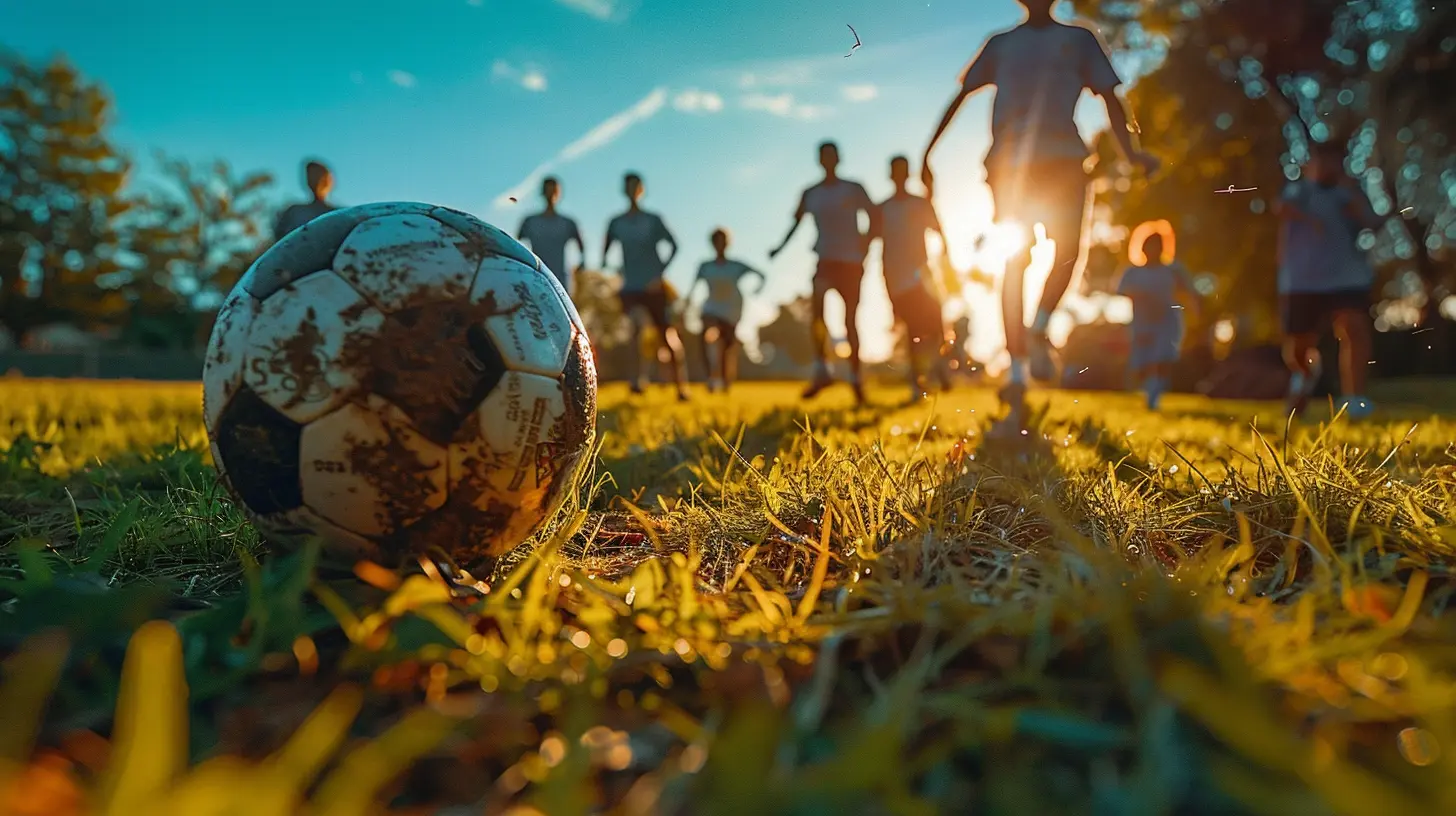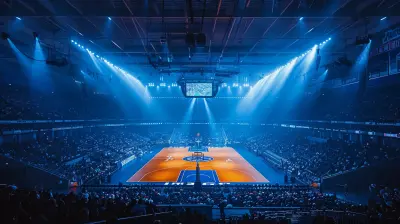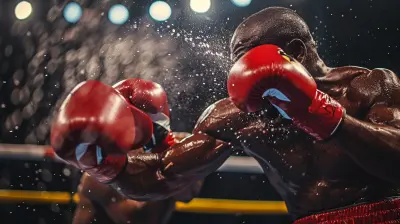Fostering Creativity and Flexibility in Team Tactics
10 March 2025
In the ever-competitive world of sports, it’s no longer enough for teams to rely solely on physical prowess or traditional playbooks. To succeed, teams must embrace creativity and flexibility. Whether on the soccer field, basketball court, or in any team sport, creating innovative strategies and adapting on the fly are becoming invaluable assets. Why? Because the sports landscape is constantly changing, and the teams that can think outside the box — while maintaining a degree of tactical flexibility — are often the ones that come out on top.
But how do you foster creativity in a team environment? And more importantly, how can flexibility in tactics be nurtured without sowing confusion or chaos? That's what we’re going to dive into today.
Let’s break it down step by step.

Why Creativity and Flexibility Matter in Team Tactics
Imagine a football team that sticks rigidly to the same set of plays every game, no matter what their opponents throw at them. What would happen? Eventually, they’d get figured out. Opposing teams would learn to predict their moves and neutralize their strengths.The same goes for any team sport. When a team becomes predictable, it becomes beatable.
That’s where creativity and flexibility come in. A creative approach can catch opponents off guard, while flexibility allows your team to adapt to changing conditions during the game. The combination of these two elements keeps your opponents guessing and, more importantly, gives you the upper hand when things don’t go according to plan.
The Balance Between Structure and Freedom
Before we go any further, we need to clarify one thing: creativity doesn’t mean chaos. In fact, fostering creativity in team tactics needs to be done within a structured framework. A team without any structure is like a jazz band where everyone is playing a different tune — it’s just noise.However, just like in jazz, once the structure is in place, there’s room for improvisation. Structured tactics give the team a stable foundation, but within that structure, there must be room for quick thinking, individual flair, and adaptive strategies.
Finding that balance between structure and freedom is critical. You want your players to follow a game plan, but you also want them to feel empowered to take risks, try new things, and adjust their approach when necessary.

Encouraging Creative Thinking in Team Sports
So, how can you encourage your team to think creatively? Here are a few strategies that can help foster a more innovative mindset.1. Promote a Growth Mindset
First and foremost, you need to cultivate a growth mindset within your team. This means encouraging players to see challenges as opportunities to grow rather than insurmountable obstacles. When players are afraid of making mistakes, they’re less likely to take risks or try new things. But a growth mindset turns failure into a learning experience.For example, let’s look at a basketball team. If players know they won’t be heavily criticized for attempting a new play — even if it doesn’t work out — they’ll feel more comfortable getting creative on the court. The key is to create an environment where experimentation is encouraged, and mistakes are seen as part of the process.
2. Encourage Open Communication
Creativity thrives in environments where ideas are freely exchanged. Encourage open communication among your players. Ask them for input on strategies, and be open to their suggestions. Sometimes, the best ideas come from unexpected places.In soccer, for instance, a coach might have set formations, but if a player notices a weakness in the opposition that the coach hasn’t spotted, they should feel empowered to speak up. This kind of open dialogue encourages players to think more critically about the game and contribute to the team’s overall strategy.
3. Break Away from Routine
While consistency is important in training, falling into the trap of repetitive drills and exercises can stifle creativity. Mix things up! Introduce new drills, play unconventional games, or challenge your players with unexpected scenarios.A volleyball coach, for example, could occasionally run practice sessions where players switch positions or play with modified rules. This forces them to think differently and adapt to new situations, which helps build both creativity and tactical flexibility.
4. Use Scenario-Based Training
One of the best ways to foster creativity is through scenario-based training. Present your team with specific in-game scenarios that require them to think on their feet. For example, in rugby, you could simulate being down by a try with only a few minutes left on the clock. How does the team respond? Do they stick to the game plan, or do they adapt and come up with a new approach?These scenarios help players develop problem-solving skills and teach them how to adapt when things don’t go according to plan.
5. Highlight Creative Play in Film Sessions
Film sessions are a great way to reinforce creative thinking. When reviewing game footage, don’t just focus on mistakes or tactical errors. Highlight moments of creative brilliance, whether it’s a clever pass, an unexpected play, or a successful improvisation.For instance, in hockey, if a player makes an inventive play that leads to a goal, make sure to spotlight that moment in the film room. This not only boosts the confidence of the player involved but also signals to the rest of the team that creative solutions are valued and celebrated.

Building Tactical Flexibility
Creativity is one half of the equation; flexibility is the other. Flexibility in team tactics is essential for dealing with the unpredictable nature of sports. Opponents will throw curveballs, weather conditions may change, and things might not always go according to plan. A team that can roll with the punches and adjust its tactics on the fly will always have an advantage.1. Train for Multiple Formations and Strategies
One of the most effective ways to build flexibility is by training your team to play in multiple formations or strategies. If your team is only comfortable playing one way, they’ll struggle when forced out of their comfort zone. But if they’re familiar with several different setups, they’ll be better equipped to adapt during a game.For example, a soccer team that practices both a high-pressing 4-3-3 and a more defensive 5-4-1 will be able to switch tactics depending on the situation. If they’re up by a goal with 10 minutes left, they can shift to the more defensive formation to hold onto the lead. But if they’re chasing a goal, they can switch to the more aggressive formation to put pressure on the opposition.
2. Develop Versatile Players
Building flexibility isn’t just about tactics — it’s also about having versatile players who can perform in multiple roles. In basketball, for instance, a player who can play both guard and forward positions gives the coach more options when adjusting the team’s strategy mid-game.Encourage your players to develop skills outside of their primary role. For example, a midfielder in soccer should practice both attacking and defensive skills, while a wide receiver in football might spend time working on running back drills. The more versatile your players are, the easier it will be to shift tactics when necessary.
3. Practice Situational Awareness
Tactical flexibility also requires players to be aware of what’s happening around them. A team that can read the game and recognize when things are shifting will be able to adjust more quickly. This means training your players to pay attention to the flow of the game, the positioning of their opponents, and the overall momentum.For instance, in a basketball game, if the opposing team starts double-teaming your star player, your team needs to recognize this and adjust accordingly. Maybe that means freeing up another shooter or setting more off-ball screens to counter the defensive strategy.
4. Emphasize Quick Decision-Making
Flexibility is only useful if your players can make decisions quickly. In the fast-paced world of sports, hesitation can be the difference between success and failure. That’s why it’s essential to train your team to make quick decisions under pressure.Drills that simulate high-pressure situations — where players must make split-second decisions — are invaluable for building this skill. For example, in ice hockey, you could run a drill where players have to make a pass within two seconds of receiving the puck. This encourages rapid decision-making, which will come in handy when the pressure is on during a game.
5. Have a Plan B (and C)
Finally, always have a Plan B. And a Plan C, for that matter. Preparing for multiple scenarios ensures that your team isn’t caught off guard when things don’t go as expected. This doesn’t mean you need to have a detailed script for every possible situation, but having a few alternative strategies in your back pocket can make all the difference.In football, for example, if your primary game plan revolves around the run, but the opposing defense is shutting it down, you should have a passing strategy ready to implement. Flexibility isn’t just about reacting in the moment — it’s about preparing for the unexpected.

Conclusion: Creativity and Flexibility — The Dynamic Duo
In today’s fast-paced and ever-evolving sports environment, fostering creativity and flexibility in team tactics is not just an advantage — it’s a necessity. By promoting a growth mindset, encouraging open communication, and training your team to adapt to different situations, you’ll create a more dynamic, unpredictable, and ultimately successful team.Remember, structure is important, but within that structure, there needs to be room for improvisation and adaptation. The teams that can balance both will be the ones that consistently rise to the top.
So, as you head out to your next practice or game, ask yourself: How can I encourage my team to think more creatively? And how can I build the kind of flexibility that will allow us to adapt to whatever challenges come our way?
Because in the end, it’s not just about how well you execute the plan — it’s about how well you adjust when the plan goes out the window.
all images in this post were generated using AI tools
Category:
Team ManagementAuthor:

Onyx Frye
Discussion
rate this article
16 comments
Camille Baxter
Great insights! Emphasizing creativity and flexibility in tactics can elevate team performance and adaptability in dynamic game situations.
April 3, 2025 at 4:50 AM

Onyx Frye
Thank you! I appreciate your thoughts and completely agree—creativity and flexibility are key to enhancing team performance in ever-changing scenarios.
Wendy Thomas
Creativity and flexibility? Please! If only teams spent as much time on strategy as they do on their Instagram feeds. Let's see some real innovation on the field, not just flashy moves. Otherwise, it's just another boring game with predictable plays!
March 31, 2025 at 7:07 PM

Onyx Frye
I appreciate your perspective! Balancing strategy with creativity is essential for true innovation in gameplay. While flashy moves can be exciting, a solid strategic foundation ultimately leads to more engaging and dynamic matches.
Joy McEachern
Emphasizing creativity enhances adaptability, crucial for modern team success.
March 28, 2025 at 1:18 PM

Onyx Frye
Thank you for your insight! I completely agree—creativity is key to navigating challenges and driving team success in today's dynamic environment.
Arwen Acevedo
Embrace innovation and adaptability; they’re keys to unlocking your team's full potential!
March 27, 2025 at 8:54 PM

Onyx Frye
Absolutely! Embracing innovation and adaptability is essential for unleashing creativity and enhancing team dynamics. Thank you for your insights!
Issac Summers
Great insights on enhancing team dynamics! Emphasizing creativity and flexibility can truly elevate performance and foster a winning mentality.
March 26, 2025 at 8:25 PM

Onyx Frye
Thank you! I appreciate your feedback and completely agree—creativity and flexibility are key to unlocking a team's full potential.
Natasha Huffman
Great article! I appreciate how you emphasized the importance of creativity and flexibility in team tactics. In today’s fast-paced sports environment, adapting strategies can make all the difference. Looking forward to seeing how teams implement these ideas in upcoming games!
March 26, 2025 at 3:51 AM

Onyx Frye
Thank you for your kind words! I'm glad you found the discussion on creativity and flexibility valuable. Excited to see how teams apply these concepts in their strategies!
Kate Wilkerson
This article highlights the importance of creativity and adaptability in team tactics. Emphasizing innovative strategies can enhance performance, but it's crucial to balance discipline and structure for long-term success.
March 25, 2025 at 5:41 AM

Onyx Frye
Thank you for your insights! I completely agree that balancing creativity with structure is essential for sustainable team success.
Sari Mahoney
This article brilliantly highlights the importance of creativity and flexibility in team tactics. Emphasizing adaptability allows teams to respond effectively to opponents and game situations. Striking a balance between structured strategy and innovative play can lead to greater success on the field. Great insights!
March 24, 2025 at 5:57 AM

Onyx Frye
Thank you for your thoughtful comments! I'm glad you found the emphasis on creativity and adaptability valuable for team success.
Oberon Estes
Great insights on the importance of creativity and flexibility in team tactics! Embracing these elements not only boosts performance but also keeps the game exciting. Can't wait to see how teams adapt!
March 23, 2025 at 11:48 AM

Onyx Frye
Thank you! I'm glad you found the insights valuable. Embracing creativity and flexibility truly can transform team dynamics and enhance the overall experience. Exciting times ahead!
Mitchell Flores
Embracing creativity and flexibility in team tactics is essential; it transforms strategy into dynamic play and enhances overall performance.
March 21, 2025 at 3:23 AM

Onyx Frye
Thank you for your insightful comment! I completely agree—embracing creativity and flexibility truly empowers teams to adapt and thrive, leading to enhanced performance and innovative strategies.
Avery Harris
Ah, fostering creativity in team tactics—like trying to teach a cat to fetch! It's all about flexibility, right? Let’s hope the coach isn’t expecting Picasso levels of artistry on the field while dodging the opposing team like a kid avoiding broccoli. Bring on the ‘creative chaos’!
March 19, 2025 at 11:38 AM

Onyx Frye
Absolutely! Embracing 'creative chaos' can lead to unexpected breakthroughs, much like teaching a cat to fetch—it's all about adapting and finding what works best for the team.
Noah Porter
In a world where tradition meets innovation, the dance of tactics unfolds. What if the key to victory lies not in rigid playbooks, but in the whispers of instinct and adaptation? Creativity might just be the secret weapon that reshapes the game—if only the right minds dare to embrace it.
March 15, 2025 at 8:47 PM

Onyx Frye
Absolutely! Embracing creativity and adaptability in tactics can transform traditional strategies into dynamic breakthroughs, allowing teams to thrive in unpredictable environments.
Felicity Cannon
I truly appreciate this insightful article on team tactics. The emphasis on creativity and flexibility is so vital in today’s game. It reminds us that success isn’t just about strategy, but also about encouraging players to think outside the box and adapt. Inspiring read—thank you for sharing!
March 14, 2025 at 1:34 PM

Onyx Frye
Thank you for your kind words! I'm glad you found the article inspiring. Creativity and flexibility are indeed crucial for success in today’s game.
Juliet Kane
This article highlights the essential balance between structure and creativity in team tactics. Emphasizing flexibility not only enhances gameplay but also fosters a team culture that encourages innovation and adaptive strategies.
March 11, 2025 at 9:31 PM

Onyx Frye
Thank you for your insightful comment! I completely agree that balancing structure with creativity is key to enhancing both gameplay and team dynamics.
Zayn Peterson
Team tactics should prioritize creativity over conformity. Embracing flexibility unlocks potential, allowing players to innovate on the field. It's time to ditch rigid strategies and unleash true game-changing talent!
March 11, 2025 at 5:56 AM

Onyx Frye
I completely agree! Emphasizing creativity and flexibility in team tactics not only enhances individual expression but also opens up new strategic possibilities that can truly elevate the game.
Kenna Lawrence
This article brilliantly highlights the importance of creativity and flexibility in team tactics. Embracing these qualities can truly transform gameplay and lead to more dynamic and successful teams. Well done!
March 10, 2025 at 1:25 PM

Onyx Frye
Thank you for your thoughtful feedback! I'm glad you found the article insightful and that it resonates with the transformative power of creativity and flexibility in team tactics.
MORE POSTS

Exploring the Top Surf Destinations Around the Globe

How Technology is Changing the Way We View Professional Sports

Guerrilla Marketing Tactics to Boost Your Sports Event

The Science of Football Fitness and Endurance Training

Mastering the Art of Carving: Skiing Techniques for Every Slope

The Emergence of Football Academies and Their Global Impact

The Importance of Consistent Branding in Sports Marketing

Top Prospects to Watch in the Upcoming Draft

Understanding Snow Conditions and How They Affect Your Skiing

Analyzing the Most Technical Boxers of All Time